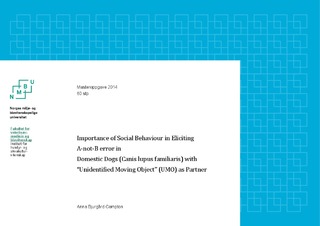| dc.contributor.author | Compton, Anna Bjurgård | |
| dc.date.accessioned | 2015-02-27T10:19:18Z | |
| dc.date.available | 2015-02-27T10:19:18Z | |
| dc.date.copyright | 2014 | |
| dc.date.issued | 2015-02-27 | |
| dc.identifier.uri | http://hdl.handle.net/11250/277949 | |
| dc.description.abstract | Domestic dogs (Canis lupus familiaris) are highly sociable animals that are observed to be experts at interacting, understanding and cooperating with humans (Homo sapiens). Social behaviour is difficult to study due to the lack of full control over interactions, but is important for understanding and interacting effectively with dogs. Robots have recently been introduced into canine research as a tool to investigate dog social behaviour. Unidentified Moving Object (UMO) is a term to explain a robotic agent unfamiliar to the dog. Previous research done with UMO’s mostly focuses on dogs’ responses to the appearance of a UMO. To investigate the importance of the UMO’s social behaviour in interaction with dogs, the traditional Piagetian A-not-B error test was used to compare three treatment groups each comprising 16 dogs: a Human partner group, a Social UMO partner group and a Non-Social UMO partner group. The two UMO groups had the same UMO but the behaviour of the UMO was different. The Social UMO interacted with the dog in a problem-solving task that the dog was not capable of solving but the UMO was, leading to the UMO giving the reward to the dog. The Non-Social UMO had a treatment phase where it drove in a mechanical manner continuously around in a circle, not responding to any of the dog’s actions. The Human group served as a positive control group. Dogs in the Non-Social treatment group performed well above chance level in the crucial trials, not performing the A-not-B error, indicating that they did not consider the behaviour of the UMO to be of importance in solving the problem. Dogs in the Social-UMO treatment group on the other hand had a similar pattern to dogs in the Human group in the crucial trials, just not of the same levels of magnitude. These results suggest that the social behaviour of the UMO in the test prompted the dogs to perform the A-not-B error, implying that they considered the information gained during interaction with the UMO to be of importance. This experiment showed that the type of interaction the dog had with the UMO immediately prior to the test (in the Social or Non-Social treatment phase) was an important factor in whether or not the UMO would elicit the A-not-B error. The results indicate that dogs may not be just good at interacting with humans (“man’s best friend”), but might in fact be very plastic for interaction with mutually inclined partners or agents, and that in these interactions social behaviour is an important factor. | nb_NO |
| dc.language.iso | eng | nb_NO |
| dc.publisher | Norwegian University of Life Sciences, Ås | |
| dc.rights | Navngivelse 3.0 Norge | * |
| dc.rights.uri | http://creativecommons.org/licenses/by/3.0/no/ | * |
| dc.title | Importance of social behaviour in eliciting A-not-B error in domestic dogs (Canis lupus familiaris) with “Unidentified Moving Object” (UMO) as partner | nb_NO |
| dc.type | Master thesis | nb_NO |
| dc.subject.nsi | VDP::Agriculture and fishery disciplines: 900 | nb_NO |
| dc.subject.nsi | VDP::Agriculture and fishery disciplines: 900::Agriculture disciplines: 910::Other agricultural disciplines: 919 | nb_NO |
| dc.subject.nsi | Ethology | nb_NO |
| dc.source.pagenumber | 35 | nb_NO |
| dc.description.localcode | M-HV | nb_NO |

